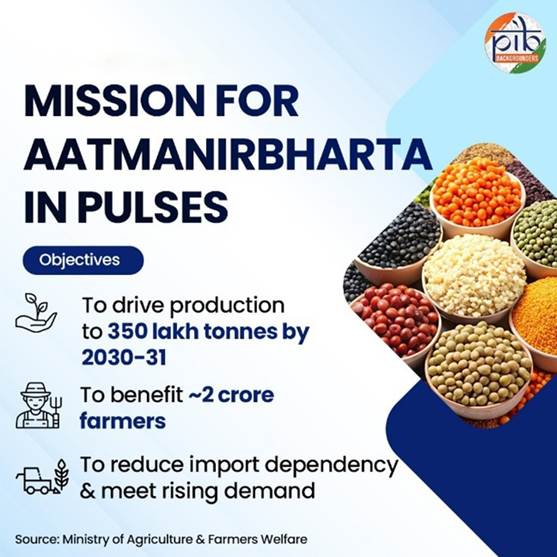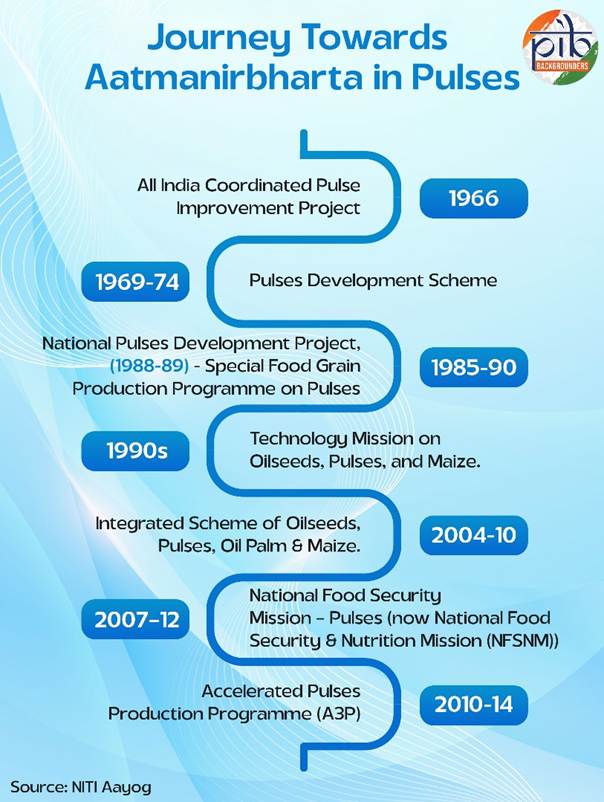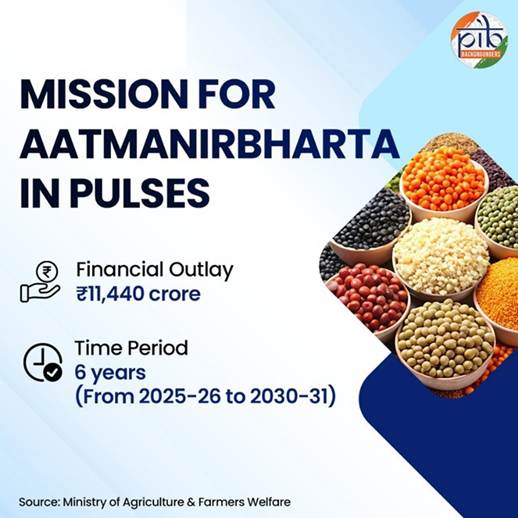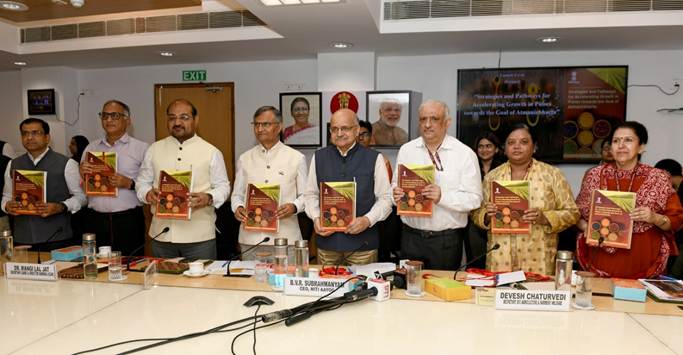PIB Headquarters
India’s Mission for Aatmanirbharta in Pulses
Enhancing Production and Farmers’ Income
प्रविष्टि तिथि:
11 OCT 2025 6:12PM by PIB Delhi
|
Key Takeaways
- Prime Minister launched the Mission for Aatmanirbharta in Pulses (2025–26 to 2030–31) with a budgetary allocation of ₹11,440 crore on October 11, 2025.
- It aims to scale up domestic pulses production to 350 lakh tonnes and expand the cultivation area to 310 lakh hectares by 2030–31.
- It aims to ensure 100 percent procurement of Tur, Urad, and Masoor at MSP for four years.
- A total of 88 lakh free seed kits and 126 lakh quintals of certified seeds will be distributed among farmers.
- Nearly 2 crore farmers are expected to gain from guaranteed procurement, quality seed distribution, and enhanced value chain support.
|
Introduction
Pulses are more than just an agricultural commodity; they are a keystone of India’s nutritional security, soil health, and rural livelihoods. As the world’s largest producer, consumer, and importer of pulses, India’s policies have consistently focused on enhancing productivity and sustainability in this vital sector. With rising incomes and growing awareness of balanced nutrition, demand for pulses has been steadily increasing, creating opportunities to increase domestic production.
Beyond their economic and trade significance, pulses serve as a nutritional powerhouse. As per the National Institute of Nutrition, they contribute nearly 20-25 percent of total protein intake in Indian diets. However, the per capita consumption of pulses continues to fall short of the recommended 85 grams per day, contributing to protein-energy malnutrition across the country. Therefore, enhancing domestic production is not only an economic necessity but also a vital step toward improving public health.
Recognizing this dual importance, the Government of India has placed strong emphasis on strengthening the pulses sector. A special Krishi programme was held at the Indian Agricultural Research Institute (IARI), New Delhi, on 11 October 2025, where Prime Minister Shri Narendra Modi launched the Mission for Aatmanirbharta in Pulses (Dalhan Aatmanirbharta Mission) with a total outlay of ₹11,440 crore. During the event, the Prime Minister interacted with farmers involved in pulse cultivation and highlighted the importance of promoting value chain–based growth across agriculture and allied sectors. It was emphasized during the launch that the mission aims not only to enhance pulse production but also to build a sustainable and empowered future.
This mission represents a major step toward achieving nutritional security and self-sufficiency. The Mission for Aatmanirbharta in Pulses was announced in the Union Budget 2025–26 and was approved by the Union Cabinet on 1st Oct 2025. It will be implemented during 2025–26 to 2030–31. It seeks to boost domestic production, reduce import dependence, and pave the way for an “Aatmanirbhar Bharat” in pulses.

Background
Over the years, India has experienced a significant transformation in pulses production. Consistent government efforts under the National Food Security and Nutrition Mission (NFSNM) have driven production up from 192.6 lakh tonnes in 2013–14 to 252.38 lakh tonnes in 2024-25(3ʳᵈ Advance Estimates), reflecting an impressive growth over 31 percent. While this progress is commendable, considerable potential remains to further enhance production and meet the country’s increasing consumption requirements. In 2023–24, India imported 47.38 lakh tonnes of pulses, even as it exported 5.94 lakh tonnes, highlighting opportunities for structural improvement. This reflects that, despite being among the world’s largest pulses producers, India’s domestic production has significant scope to grow to fully meet demand, making imports a necessary supplement. With pulses imports reaching 47.38 lakh tonnes in 2023–24, the government has prioritized achieving self-sufficiency in pulses as a key national objective.
Prime Minister Shri Narendra Modi has set the ambitious goal of making India fully aatmanirbhar (self-reliant) in pulses by December 2027, with particular focus on Tur (Arhar), Urad, and Masoor. The new Mission strengthens this vision by aiming to meet India’s future pulses demand entirely through domestic production. The Mission is aligned with Vision 2047, emphasizing sustainable growth, diversified cropping patterns, and the empowerment of farmers through assured income, adoption of advanced technologies, and climate-resilient agricultural practices.
The Government of India has consistently promoted pulses production through targeted initiatives over the decades. Beginning with the All India Coordinated Pulse Improvement Project in 1966 to Accelerated Pulses Production Programme (A3P) (2010–14) built on these initiatives to enhance productivity and lay the groundwork for long-term self-reliance.

Objective
The Mission for Aatmanirbharta in Pulses (2025–31) aims to achieve self-sufficiency in pulses by significantly enhancing domestic production, reducing import dependence, and sustainably improving farmers’ incomes. The Mission plans to expand the area under pulses cultivation by an additional 35 lakh hectares, targeting rice fallows and other suitable lands, while promoting intercropping and crop diversification. A key focus will be the development and dissemination of high-yielding, pest-resistant, and climate-resilient pulses varieties, supported by a robust seed system. This includes the production and distribution of 126 lakh quintals of certified seeds and the free provision of 88 lakh seed kits to farmers.

Operational Strategy for Aatmanirbharta in Pulses
To ensure effective implementation, states will prepare rolling five-year seed production plans, with breeder seed production monitored by ICAR and quality assurance maintained through the SATHI portal (seedtrace.gov.in). The Mission adopts a holistic approach, integrating soil health management, mechanization, balanced fertilizer application, plant protection, and large-scale demonstrations facilitated by ICAR, Krishi Vigyan Kendras (KVKs), and state agricultural departments. Through these measures, the Mission envisions a resilient, self-reliant pulses production system that meets India’s growing domestic demand.
SATHI - Seed Authentication, Traceability & Holistic Inventory
SATHI is a user-oriented centralized portal. Envisioned and created by the Ministry of Agriculture and Farmers’ Welfare, Govt. of India, in partnership with National Informatics Centre (NIC). SATHI provides a holistic approach to encompass the complete seed life cycle over multiple seed generations. This measure is achieved through automation of the entire seed supply chain, starting from seed production to certification, licensing, seed Inventory, and seed sale by certified dealers to seed growers and includes traceability of seeds.
To provide farmers with greater income security and confidence in pulses cultivation, the Government will ensure the assured procurement of key pulses; Tur (Arhar), Urad, and Masoor; under the Pradhan Mantri Annadata Aay SanraksHan Abhiyan (PM-AASHA). The National Agricultural Cooperative Marketing Federation of India (NAFED) and the National Cooperative Consumers’ Federation (NCCF) will ensure 100 percent procurement in participating states over the next four years. This mechanism guarantees fair and timely prices, reduces market uncertainties, and encourages farmers to adopt high-value pulses crops, thereby contributing to the overarching goal of pulses self-reliance. Through these concerted efforts, the Mission envisions a resilient, sustainable, and self-reliant pulses production system that meets India’s growing domestic demand and strengthens farmers’ livelihoods.
The Mission also seeks to strengthen the post-harvest value chain by establishing 1,000 processing and packaging units, supported by subsidies of up to ₹25 lakh per unit, aimed at reducing losses, enhancing value addition, and generating rural employment. Interventions will follow a cluster-based approach as recommended by NITI Aayog, facilitating efficient resource utilization and promoting geographic diversification of pulses cultivation. By 2030–31, the Mission targets expanding pulses cultivation to 310 lakh hectares, increasing production to 350 lakh tonnes, and improving yields to 1,130 kg/ha. In addition to these production goals, the Mission aims to conserve foreign exchange by reducing imports, promote climate-resilient and soil health-friendly practices, and create substantial employment opportunities, thereby ensuring nutritional security and long-term self-reliance in pulses.
Pradhan Mantri Annadata Aay Sanrakshan Abhiyan (PM-AASHA)
The Pradhan Mantri Annadata Aay SanraksHan Abhiyan (PM-AASHA) was launched in September 2018 with the objective of providing price assurance for pulses, oilseeds, and copra, thereby ensuring financial stability for farmers, reducing post-harvest distress sales, and promoting crop diversification toward pulses and oilseeds. In September 2024, the Cabinet approved the continuation of the integrated PM-AASHA scheme, comprising its key components: the Price Support Scheme (PSS), Price Deficiency Payment Scheme (PDPS), and Market Intervention Scheme (MIS).
Recommendations from NITI Aayog

Launch of NITI Aayog Report on Aatmanirbharta in Pulses on September 4, 2025
Based on insights from 885 farmers across five major pulses-growing states, Rajasthan, Madhya Pradesh, Gujarat, Andhra Pradesh, and Karnataka, NITI Aayog has outlined recommendations to strengthen the pulses sector, enhance productivity, and ensure sustainability. Key measures include expanding pulses into rice fallows and diversifying cropping patterns through a cluster-based approach, complemented by incentives, assured prices, and pilot projects in high-potential states. To strengthen seed systems, NITI Aayog advocates for high-quality seed supply and traceability via models such as “One Block–One Seed Village”, supported by cluster-based seed hubs and Farmer-Producer Organizations (FPOs) to ensure the timely availability of improved varieties and higher yields. Strengthening procurement and value chains through local procurement centers and processing units will reduce intermediaries, improve farmer incomes, and stabilize consumer prices. Integrating pulses into nutrition and welfare programs such as PDS and Mid-Day Meals will boost demand and address malnutrition. The report (Refer NITI Aayog report here) emphasizes mechanization, efficient irrigation, and bio-fertilizers for sustainable productivity, alongside pest-resistant, short-duration, and climate-resilient varieties, supported by early warning systems and data-driven monitoring via the SAATHI Portal, to make pulses cultivation more resilient and rewarding.
Conclusion
The “Mission for Aatmanirbharta in Pulses” marks a significant stride toward achieving both nutritional and economic security for India. By prioritizing self-reliance, the Mission empowers farmers through technology adoption, assured procurement, capacity building, and access to quality seeds, while promoting sustainable and climate-resilient practices.
Through a combination of scientific innovation, cluster-based interventions, and strengthened value chains, the Mission aims not only to meet domestic pulses demand but also to reduce import dependence, enhance farmer incomes, and position India as a global leader in sustainable pulses production. By integrating pulses into nutrition programs, improving post-harvest infrastructure, and fostering rural employment, the Mission’s impact will extend beyond food security to soil health, rural prosperity, and the realization of a Viksit Bharat.
In essence, the Mission lays the foundation for a self-reliant, resilient, and productive pulses sector, ensuring long-term benefits for farmers, consumers, and the nation as a whole.
References:
- https://www.pib.gov.in/PressReleasePage.aspx?PRID=2173547
- https://www.pib.gov.in/PressReleaseIframePage.aspx?PRID=2039209
- https://www.pib.gov.in/PressReleasePage.aspx?PRID=2085530
- https://static.pib.gov.in/WriteReadData/specificdocs/documents/2022/feb/doc202221616601.pdf
- https://www.pib.gov.in/PressReleasePage.aspx?PRID=1993155
Click here to see pdf
****
VV/SM
(रिलीज़ आईडी: 2177847)
आगंतुक पटल : 10380